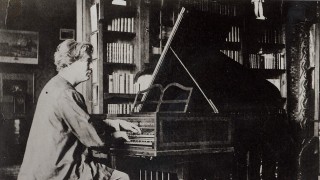Title

Ferruccio Busoni (1866–1924)
“Bach is the foundation of piano playing, Liszt the summit,” observed Ferruccio Busoni, who is most commonly thought of as a hyphenate—how often do we see “Bach-Busoni” on recital programs?—but doctoral student Jiayan Sun (Pre-College '08; BM '12, MM '14, piano) makes a case for him as much more in advance of his January 19 Busoni recital.
Body
Rigorously trained as a contrapuntist, Ferruccio Busoni (1866–1924) was a loyal follower of Bach; he and two of his pupils edited, arranged, and transcribed virtually all of Bach's keyboard works. These transcriptions, still popular today, revived what was at the time neglected repertoire, and offered Busoni opportunities for new pianistic possibilities. After meeting Wilhelm Middelschulte, known as the Meister der Kontrapunkte, in Chicago during a 1910 concert trip, Busoni discovered a new compositional sphere exploiting intense contrapuntal activities. With vertical considerations subordinated to horizontal movements, he joined Schoenberg and his pupils in developing the atonal language. The resulting masterpiece, Fantasia contrappuntistica, not only paid homage to Bach and The Art of Fugue but also formed Busoni's compositional style with Neo-Classicism and the emancipation of dissonance. Around the same time, Busoni contemplated the development of musical language with exploitations of chromaticism in relationship to the traditional music notation.
While Busoni was a young pianist, he heard—but wasn't impressed by—the masterful playing of the aged Franz Liszt. It wasn't until the early 1890s, as a piano faculty member at the New England Conservatory, that Busoni rediscovered Liszt, whose compositions became his model in dazzling virtuosity and kaleidoscopic effects and whose thinking shaped his musical personality. As a result, though Busoni never studied with Liszt, he was considered the true heir of Liszt's legacy, culminating with six recitals of all-Liszt programs in Berlin in 1911. None of Liszt's pupils accomplished this, nor has any pianist to this day. Near the end of his life, in the midst of his laborious creation of the opera Doktor Faust, Busoni paid homage to Liszt by creating a chamber fantasia on Bizet’s Carmen called Sonatina No. 6, thus realizing a vision that had been spelled out in the preface to his edition of Liszt’s Don Juan Fantasy a few years earlier.
With his incredible accomplishments, why is Busoni marginalized in concert programs and our understanding of music history? In our efforts to interpret music with increasing awareness of authenticity and fidelity, we tend to dismiss Busoni's editions, arrangements, and transcriptions as old-fashioned parodies, useless in our time and disrespectful to the masters. But Busoni and his contemporaries accomplished an enormous amount in searching for authentic instruments and studying historical performance practices. By adopting the modern instruments and manipulating the original texts, they sought spiritual rather than textual fidelity to the masterpieces. In the case of Bach and Liszt as well as in his own work and that of his contemporaries, Busoni constantly reimagined the presentation of the work and discovered the infinite potential of the music. The musicologist Donald Francis Tovey commented on Busoni's spiritual fidelity to Mozart in his being “an absolute purist in not confining himself strictly to Mozart's written text.” As we celebrate Busoni's sesquicentennial, let's continue searching for new and profound expressions in music as we define and redefine musical interpretations through experimentation and unlimited possibility.




